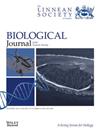形态和分子相似的同域海绵物种的平行表型可塑性和不同的生态策略
IF 1.5
3区 生物学
Q3 EVOLUTIONARY BIOLOGY
引用次数: 0
摘要
表型可塑性如何促进或阻碍适应性变化和多样化?在实验上回答这个关键问题可能很难,但密切相关的克隆物种允许一种直接的方法:通过实验激发表型可塑性来评估可塑性性状和物种差异的适应意义。两种常见的加勒比海绵,Aplysina fulva和A. cauliformis,在分子上几乎无法区分,并且具有相同的生长形式、栖息地和地理范围。这就提出了关于物种边界、物种内变异和物种形成机制的问题。为了区分表型可塑性和遗传变异,并了解可塑性如何影响适应和分化进化,我们:(I)量化形态和生态特征,(ii)通过在不同环境中生长无性系揭示表型可塑性,以及(iii)将可塑性形态特征与生态功能联系起来。这些特征包括骨骼纤维密度、生物力学特性、对寄生虫和捕食者的脆弱性、伤口愈合、运输途径、碎片传播、种群动态以及在不同食物、阳光、捕食者和水流环境下的生长和存活。将这两个物种移植到不同的环境中,在相同的性状上产生了平行的可塑性。综合比较和实验数据揭示了生态相关特征的综合套件,这些特征清楚地区分了这些物种,并允许解释可能构成分化的可塑性特征的适应性意义。本文章由计算机程序翻译,如有差异,请以英文原文为准。
Parallel phenotypic plasticity and divergent ecological strategies in morphologically and molecularly similar sympatric sponge species
How can phenotypic plasticity promote or impede adaptive change and diversification? Answering this key question can be experimentally intractable, but closely related clonal species allow a direct approach: experimentally provoking phenotypic plasticity to assess the adaptive significance of both plastic traits and species differences. Two common Caribbean sponge species, Aplysina fulva and A. cauliformis, are nearly indistinguishable molecularly, and share growth form, habitat, and geographical range. This raises questions about species boundaries, within-species variability, and mechanisms of speciation. To distinguish phenotypic plasticity from genetic variation, and learn how plasticity might influence adaptive—and divergent—evolution, I: (i) quantified morphological and ecological characters, (ii) revealed phenotypic plasticity by growing clonemates in different environments, and (iii) related plastic morphological features to ecological function. Characters included skeletal fibre density, biomechanical properties, vulnerability to parasites and predators, wound healing, transport pathways, propagation by fragments, population dynamics, and growth and survival in settings differing in food, sunlight, predators, and water motion. Transplanting both species to a different environment elicited parallel plasticity in the same traits. Combined comparative and experimental data reveal integrated suites of ecologically relevant characters that clearly distinguish these species and allow interpretation of adaptive significance of plastic characters that may underlie divergence.
求助全文
通过发布文献求助,成功后即可免费获取论文全文。
去求助
来源期刊
CiteScore
4.30
自引率
10.50%
发文量
140
审稿时长
3-6 weeks
期刊介绍:
The Biological Journal of the Linnean Society is a direct descendant of the oldest biological journal in the world, which published the epoch-making papers on evolution by Darwin and Wallace. The Journal specializes in evolution in the broadest sense and covers all taxonomic groups in all five kingdoms. It covers all the methods used to study evolution, whether whole-organism or molecular, practical or theoretical.d.

 求助内容:
求助内容: 应助结果提醒方式:
应助结果提醒方式:


